Acer R14 User Manual
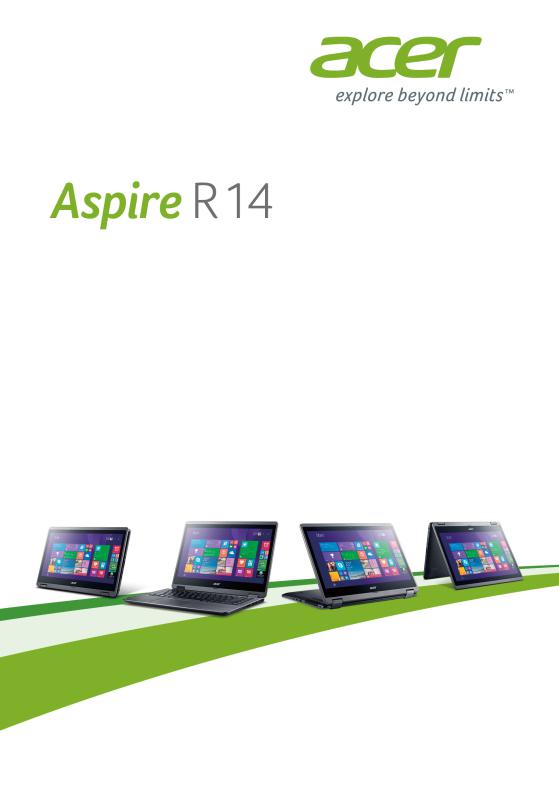
User’s Manual

2 -
© 2014. All Rights Reserved. Aspire R 14
Covers: R3-471TG / R3-471T / R3-431TG / R3-431T This revision: August 2014
Sign up for an Acer ID and enjoy great benefits
Open the Acer Portal app from the Start screen to sign up for an Acer ID or sign in if you already have an Acer ID.
There are three great reasons for you to get an Acer ID:
•Build Your Own Cloud with Acer BYOC.
•Get the latest offers and product information.
•Register your device for warranty service.
For more information, please visit the AcerCloud website:
www.acer.com/byoc-start
Important
This manual contains proprietary information that is protected by copyright laws. The information contained in this manual is subject to change without notice. Images provided herein are for reference only and may contain information or features that do not apply to your computer. Acer Group shall not be liable for technical or editorial errors or omissions contained in this manual.
Model number: _________________________________
Serial number: _________________________________
Date of purchase: ______________________________
Place of purchase: ______________________________

Table of contents - 3
TABLE OF CONTENTS
First things first |
2 |
Your guides ............................................. |
2 |
Basic care and tips for using your |
|
computer.................................................. |
2 |
Turning your computer off........................... |
2 |
Taking care of your computer ..................... |
3 |
Taking care of your AC adapter .................. |
3 |
Cleaning and servicing................................ |
4 |
Your Acer notebook tour |
5 |
Screen view ............................................. |
5 |
Keyboard view ...................................... |
6 |
Front view ............................................... |
7 |
Left view ................................................. |
7 |
Information on USB 3.0............................... |
8 |
Right view ............................................... |
8 |
Base view ................................................ |
9 |
Using the keyboard |
10 |
Lock keys and embedded numeric |
|
keypad ................................................... |
10 |
Hotkeys ..................................................... |
11 |
Windows keys........................................ |
12 |
Touchpad |
13 |
Touchpad basics ................................... |
13 |
Touchpad gestures................................ |
13 |
Recovery |
15 |
Creating a recovery backup................... |
15 |
Creating a drivers and applications |
|
backup ................................................... |
17 |
Recovering your system ........................ |
19 |
Reinstalling drivers and applications......... |
20 |
Returning to an earlier system snapshot .. |
22 |
Returning your system to its factory |
|
condition.................................................... |
23 |
Recovering from Windows ........................ |
23 |
Recovering from a recovery backup ......... |
26 |
Connecting to the Internet |
29 |
Connecting with a cable ........................ |
29 |
Built-in network feature ............................. |
29 |
Connecting wirelessly............................ |
30 |
Connecting to a wireless LAN................... |
30 |
.................................................................. |
30 |
Using a Bluetooth connection |
31 |
Enabling and disabling Bluetooth .......... |
31 |
Enable Bluetooth and add a device .......... |
31 |
Using AccuFinger...................................... |
34 |
RepliView .................................................. |
35 |
Settings ..................................................... |
35 |
Acer Screen Grasp |
37 |
Overview .............................................. |
37 |
Adjusting the Settings ............................... |
38 |
The editing tool ......................................... |
38 |
Acer Scrapboard |
40 |
Acer Backup Manager |
41 |
Contact pickup |
43 |
Sending your contact information .......... |
43 |
BIOS utility |
2 |
Boot sequence......................................... |
2 |
Setting passwords ................................... |
2 |
Securing your computer |
3 |
Using a computer security lock................ |
3 |
Using passwords ..................................... |
3 |
Entering passwords .................................... |
4 |
Power management |
5 |
Saving power ........................................... |
5 |
Battery pack |
7 |
Battery characteristics ............................. |
7 |
Charging the battery ................................... |
7 |
Optimizing battery life ................................. |
8 |
Checking the battery level........................... |
9 |
Battery-low warning .................................... |
9 |
Traveling with your computer |
10 |
Disconnecting from the desktop ............ |
10 |
Moving around ....................................... |
10 |
Preparing the computer ............................ |
10 |
What to bring to meetings ......................... |
11 |
Taking the computer home .................... |
11 |
Preparing the computer ............................ |
11 |
What to take with you................................ |
12 |
Special considerations .............................. |
12 |
Setting up a home office ........................... |
12 |
Traveling with the computer................... |
12 |
Preparing the computer ............................ |
13 |
What to take with you................................ |
13 |
Special considerations .............................. |
13 |
Traveling internationally......................... |
13 |
Preparing the computer ............................ |
13 |
What to bring with you .............................. |
14 |
Special considerations .............................. |
14 |
Acer Touch Tools |
33 |
Memory card reader |
2 |
Touch tool controls ................................ |
33 |
Connectivity options................................. |
2 |
Pointing ..................................................... |
34 |
4 - Table of contents |
|
Video and audio connectors |
4 |
HDMI |
5 |
Universal Serial Bus (USB) |
6 |
Frequently asked questions |
2 |
Requesting service .................................. |
4 |
Tips and hints for using Windows 8.1...... |
5 |
How do I get to Start? ................................. |
5 |
What are "Charms?" ................................... |
5 |
Can I boot directly to the desktop? ............. |
6 |
How do I jump between apps?.................... |
6 |
How do I turn off my computer?.................. |
6 |
How do I unlock my computer?................... |
6 |
How do I set the alarm? .............................. |
8 |
Where are my apps?................................... |
9 |
What is a Microsoft ID (account)?............. |
11 |
How do I add a favorite to Internet |
|
Explorer?................................................... |
11 |
How do I check for Windows updates?..... |
11 |
Where can I get more information?........... |
11 |
Troubleshooting ..................................... |
12 |
Troubleshooting tips.................................. |
12 |
Error messages......................................... |
12 |
Internet and online security |
14 |
First steps on the net ............................. |
14 |
Protecting your computer.......................... |
14 |
Choose an Internet Service Provider ........ |
14 |
Network connections................................. |
16 |
Surf the Net!.............................................. |
18 |
Security ..................................................... |
18 |

Getting started...
In this section you will find:
•Useful information on caring for your computer and your health
•Where to find the power button, ports and connectors
•Tips and tricks for using the touchpad and keyboard
•How to create recovery backups
•Guidelines for connecting to a network and using Bluetooth
•Information on using Acer’s bundled software

2 - First things first
FIRST THINGS FIRST
We would like to thank you for making this Acer notebook your choice for meeting your mobile computing needs.
Your guides
To help you use your Acer notebook, we have designed a set of guides:
First off, the Setup Guide helps you get started with setting up your computer.
The Quick Guide introduces you to the basic features and functions of your new computer. For more on how your computer can help you to be more productive, please refer to the User’s Manual. This guide contains detailed information on such subjects as system utilities, data recovery, expansion options and troubleshooting. In addition it contains general regulations and safety notices for your notebook. It is available from the desktop; double-click the Help icon and click User’s Manual in the menu that opens.
Basic care and tips for using your computer
Turning your computer off
To turn the power off, do any of the following:
•Use the Windows shutdown command: Press the Windows key + <C>, click Settings > Power then click Shut Down.
If you need to power down the computer for a short while, but don’t want to completely shut it down, you can put it into Hibernate by pressing the power button.

First things first - 3
You can also put the computer in sleep mode by pressing the sleep hotkey <Fn> + <F4>.
Note
If you cannot power off the computer normally, press and hold the power button for more than four seconds to shut down the computer. If you turn off the computer and want to turn it on again, wait at least two seconds before powering up.
Taking care of your computer
Your computer will serve you well if you take care of it.
•Do not expose the computer to direct sunlight. Do not place it near sources of heat, such as a radiator.
•Do not expose the computer to temperatures below 0º C (32º F) or above 50º C (122º F).
•Do not subject the computer to magnetic fields.
•Do not expose the computer to rain or moisture.
•Do not spill water or any liquid on the computer.
•Do not subject the computer to heavy shock or vibration.
•Do not expose the computer to dust or dirt.
•Never place objects on top of the computer.
•Do not slam the computer display when you close it.
•Never place the computer on uneven surfaces.
Taking care of your AC adapter
Here are some ways to take care of your AC adapter:
•Do not connect the adapter to any other device.
•Do not step on the power cord or place heavy objects on top of it. Carefully route the power cord and any cables away from foot traffic.
•When unplugging the power cord, do not pull on the cord itself but pull on the plug.
•The total ampere ratings of the equipment plugged in should not exceed the ampere rating of the cord if you are using an extension cord. Also, the total current rating of all equipment plugged into a
4 - First things first
single wall outlet should not exceed the fuse rating.
Cleaning and servicing
When cleaning the computer, follow these steps:
1.Turn off the computer.
2.Disconnect the AC adapter.
3.Use a soft, moist cloth. Do not use liquid or aerosol cleaners. If either of the following occurs:
• The computer has been dropped or the body has been damaged;
• The computer does not operate normally
See Frequently asked questions on page 2.

Your Acer notebook tour - 5
YOUR ACER NOTEBOOK TOUR
After setting up your computer as illustrated in the Setup Guide, let us show you around your new Acer computer.
Screen view
1
2
3
# |
Icon Item |
Description |
|
|
|
Web camera for video |
|
1 |
Webcam |
communication. |
|
A light next to the webcam indicates |
|||
|
|
||
|
|
that the webcam is active. |
|
|
|
|
|
2 |
Touchscreen |
Displays computer output, supports |
|
multi-touch input. |
|||
|
|
||
3 |
Microphone |
Internal stereo microphone for sound |
|
recording. |
|||
|
|
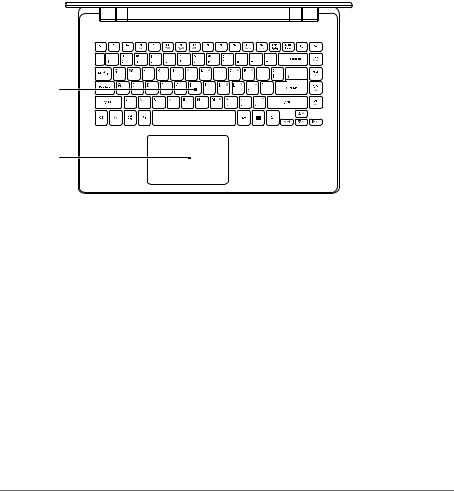
6 - Your Acer notebook tour
Keyboard view
1
2
|
|
|
# |
Icon Item |
Description |
|
|
For entering data into your computer. |
|
|
See "Using the keyboard" on page |
|
|
10. |
1 |
Keyboard |
Do not use a keyboard protector or |
|
|
similar cover as the keyboard |
|
|
includes ventilation intakes for |
|
|
cooling. |
|
|
Touch-sensitive pointing device. |
|
|
The touchpad and selection buttons |
|
|
form a single surface. |
2 |
Touchpad |
Press down firmly on the touchpad |
|
|
surface to perform a left click. |
Press down firmly on the lower right corner to perform a right click.
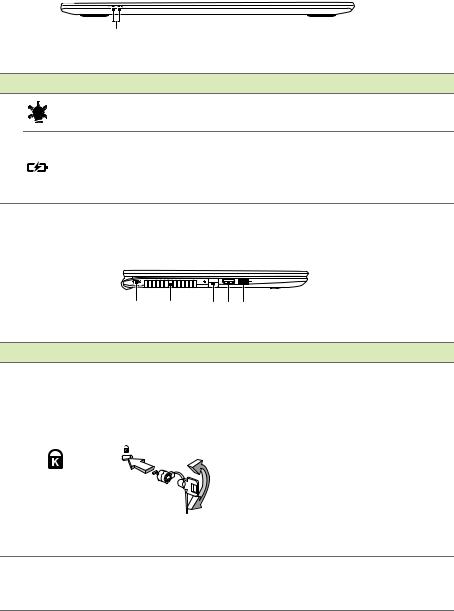
Your Acer notebook tour - 7
Front view
1 |
|
|
# Icon Item |
Description |
|
Power indicator |
Indicates the computer’s power |
|
status. |
||
|
||
1 |
Indicates battery status. |
|
Charging: The light is amber when |
||
Battery indicator |
||
the battery is charging. |
||
|
||
|
Fully charged: The light is blue. |
Left view
|
|
1 |
2 |
3 4 5 |
|
# |
Icon |
Item |
|
|
Description |
|
|
|
|
|
Connects to a Kensington- |
|
|
|
|
|
compatible computer security |
|
|
Kensington lock |
lock. |
||
|
|
Wrap the computer security lock |
|||
|
|
slot |
|
|
|
|
|
|
|
cable around an immovable |
|
1 |
|
|
|
|
|
|
|
|
|
object such as a table or handle |
|
|
|
|
|
|
of a locked drawer. |
|
|
|
|
|
Insert the lock into the notch and |
|
|
|
|
|
turn the key to secure the lock. |
|
|
|
|
|
Keyless models are also |
|
|
|
|
|
available. |
|
|
|
|
|
Allows the computer to stay cool. |
2 |
|
Ventilation |
|
Do not cover or obstruct the |
|
|
|
|
|
|
openings. |
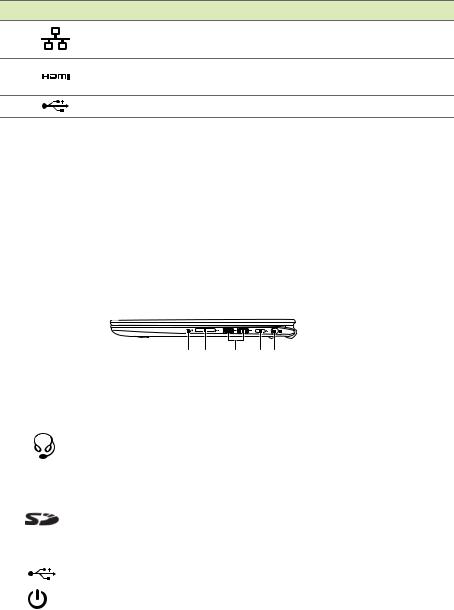
8 - Your Acer notebook tour |
|
|
|
# |
Icon |
Item |
Description |
3
4
Ethernet (RJ-45) Connects to an Ethernety 10/100/
port |
1000-based network. |
|
HDMI port |
Supports high-definition digital |
|
video connections. |
||
|
5 |
USB port |
Connects to USB devices. |
Information on USB 3.0
•USB 3.0 compatible ports are blue.
•Compatible with USB 3.0 and earlier devices.
•For optimal performance, use USB 3.0-certified devices.
•Defined by the USB 3.0 specification (SuperSpeed USB).
Right view
|
|
|
|
|
|
|
1 2 |
3 |
4 5 |
|
|
|
|
|
|
|
|
|
|
# Icon |
Item |
Description |
|||||||
1 |
|
|
|
|
|
|
Headset/speaker |
Connects to audio devices (e.g., |
|
|
|
|
|
|
|
speakers, headphones) or a headset |
|||
|
|
|
|
|
|
jack |
|||
|
|
|
|
|
|
|
with microphone. |
||
|
|
|
|
|
|
|
|
||
|
|
|
|
|
|
|
|
|
|
|
|
|
|
|
|
|
|
Accepts one Secure Digital card (SD |
|
2 |
|
|
|
|
|
|
SD card reader |
or SDHC). |
|
|
|
|
|
|
|
Push to remove/install the card. |
|||
|
|
|
|
|
|
|
|
Only one card can operate at any |
|
|
|
|
|
|
|
|
|
given time. |
|
3 |
|
|
|
|
|
|
USB ports |
Connects to USB devices. |
|
4 |
|
|
|
|
|
|
Power button |
Turns the computer on and off. |
|
|
|
|
|
|
|
|
|
|
|
5 |
|
|
|
|
|
|
DC-in jack |
Connects to an AC adapter. |
|
|
|
|
|
|
|
||||
|
|
|
|
|
|
||||
|
|
|
|
|
|
|
|
|
|
|
|
|
|
|
|
|
|
|
|
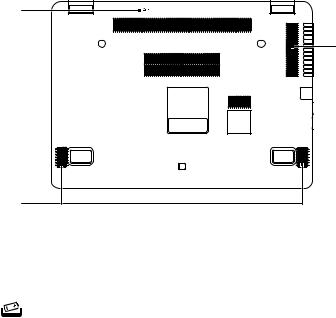
Your Acer notebook tour - 9
Base view
1
3
2
|
|
|
|
# Icon |
Item |
Description |
|
|
|
Simulates removing and reinstalling |
|
1 |
Battery reset |
the battery. |
|
pinhole |
Insert a paperclip into the hole and |
||
|
|||
|
|
press for four seconds. |
|
|
|
|
|
2 |
Speakers |
Deliver stereo audio output. |
|
|
Ventilation and |
Allows the computer to stay cool. |
|
3 |
Do not cover or obstruct the |
||
cooling fan |
|||
|
openings. |
||
|
|
||
|
|
|

10 - Using the keyboard
USING THE KEYBOARD
The keyboard has full-sized keys and an embedded numeric keypad, separate cursor, lock, Windows, function and special keys.
Lock keys and embedded numeric keypad
The keyboard has three lock keys which you can toggle on and off.
|
|
|
Lock key |
Description |
|
Caps Lock |
When Caps Lock is on, all alphabetic characters |
|
typed are in uppercase. |
||
|
When Num Lock is on, the embedded keypad is in numeric mode. The keys function as a calculator
Num Lock (complete with the arithmetic operators +, -, *, and /). <Fn> + <F11> Use this mode when you need to do a lot of numeric
data entry. A better solution would be to connect an external keypad.
When Scroll Lock is on, the screen moves one line up Scroll Lock or down when you press the up or down arrow keys <Fn> + <F12> respectively. Scroll Lock does not work with some
applications.
The embedded numeric keypad functions like a desktop numeric keypad. It is indicated by small characters located on the upper right corner of the keycaps. To simplify the keyboard legend, cursor-control key symbols are not printed on the keys.
|
|
Num Lock off |
|
Desired access |
Num Lock on |
||
Number keys on |
Type numbers in a normal |
|
|
embedded keypad |
manner. |
|
|
Cursor-control keys |
Hold <Shift> while using |
Hold <Fn> while |
|
on embedded |
cursor-control keys. |
using cursor-control |
|
keypad |
keys. |
||
|
|||
Main keyboard |
Hold <Fn> while typing |
Type the letters in a |
|
letters on embedded |
|||
keys |
normal manner. |
||
keypad. |
|||
|
|
||
|
|
|

Using the keyboard - 11
Hotkeys
The computer employs hotkeys or key combinations to access most of the computer's controls like screen brightness and volume output.
To activate hotkeys, press and hold the <Fn> key before pressing the other key in the hotkey combination.
|
|
|
|
|
|
|
|
Hotkey |
Icon |
Function |
Description |
||||
<Fn> + <F3> |
Airplane mode |
Turns on / off the computer's |
|||||
network devices. |
|||||||
<Fn> + <F4> |
Sleep |
Puts the computer in Sleep |
|||||
mode. |
|||||||
|
|
|
|
|
|
||
|
|
|
|
|
|
Switches display output |
|
<Fn> + <F5> |
Display toggle |
between the display screen, |
|||||
external monitor (if |
|||||||
|
|
|
|
|
|
||
|
|
|
|
|
|
connected) and both. |
|
|
|
|
|
|
|
|
|
<Fn> + <F6> |
|
Turns the display screen |
|||||
Display off |
backlight off to save power. |
||||||
|
|
|
|
|
|
Press any key to return. |
|
<Fn> + <F7> |
Touchpad |
Turns the built-in touchpad on |
|||||
toggle |
and off. |
||||||
|
|
|
|
|
|||
<Fn> + <F8> |
Speaker toggle |
Turns the speakers on and |
|||||
off. |
|||||||
<Fn> + <F11> |
NumLk |
Turns the embedded numeric |
|||||
keypad on or off. |
|||||||
|
|
|
|
|
|
||
<Fn> + <F12> |
Scr Lk |
Turns the scroll lock feature |
|||||
on or off. |
|||||||
|
|
|
|
|
|
||
<Fn> + < |
> |
|
|
|
Brightness up |
Increases the screen |
|
|
|
|
brightness. |
||||
|
|
|
|
|
|
||
<Fn> + < |
> |
|
|
|
Brightness |
Decreases the screen |
|
|
|
|
down |
brightness. |
|||
|
|
|
|
|
|||
<Fn> + < |
> |
|
|
|
Volume up |
Increases the sound volume. |
|
|
|
|
|
|
|
|
|
<Fn> + < |
> |
|
|
|
Volume down |
Decreases the sound volume. |
|
|
|
|
|
|
|
|
|
<Fn> + |
|
|
|
|
Play/Pause |
Play or pause a selected |
|
<Home> |
|
|
|
|
media file. |
||
|
|
|
|
|
|||
<Fn> + |
|
|
|
|
Stop |
Stop playing the selected |
|
<Pg Up> |
|
|
|
|
media file. |
||
|
|
|
|
|
|||

12 - Using the keyboard |
|
|
|
|
|
|
|
|
|
|
|
|
Hotkey |
Icon Function |
Description |
||
|
<Fn> + |
|
|
Previous |
Return to the previous media |
|
<Pg Dn> |
|
|
file. |
|
|
|
|
|
||
|
<Fn> + |
|
|
Next |
Jump to the next media file. |
|
<End> |
|
|
||
|
|
|
|
|
|
Windows keys
The keyboard has two keys that perform Windows-specific functions.
Key Description
Pressed alone it returns to the Start screen or to
Windows key return to the last open app.
It can also be used with other keys for special functions, please check Windows Help.
Application |
This key has the same effect as clicking the right |
|
mouse button; it opens the application's context |
||
key |
||
menu. |
||
|
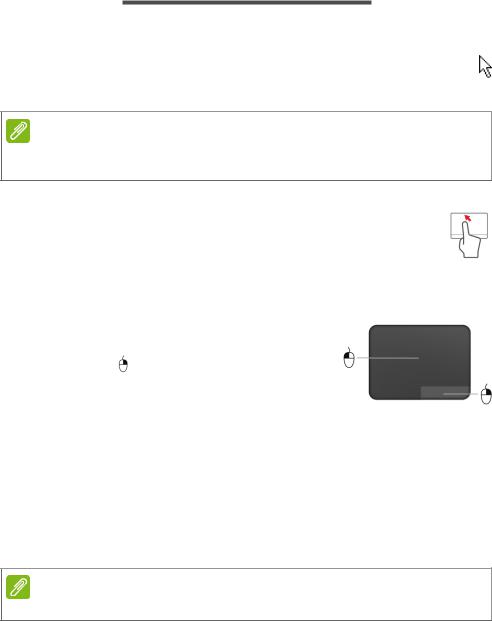
Touchpad - 13
TOUCHPAD
Touchpad basics
The touchpad controls the arrow (or 'cursor') on the screen. As you slide your finger across the touchpad, the cursor will follow this movement.
Note
The touchpad is sensitive to finger movement; the lighter the touch, the better the response. Please keep the touchpad and your fingers dry and clean.
The cursor is controlled by some basic gestures:
•Single-finger slide: Slide a finger across the touchpad to move the cursor.
•Single-finger press or tap: Press the touchpad down, or lightly tap the touchpad with your finger, to perform a 'click',
which will select or start an item. Quickly repeat the tap to perform a double tap or 'double click'.
•Single-finger press in the bottom-right corner: Press the bottom right corner of the
touchpad to perform a 'right click'. In the Start screen, this will toggle the app commands, in most apps this will open a context menu related to the selected item.
•Drag: Press and hold the bottom left corner of the touchpad, or tap twice anywhere on the touchtap, then slide a second finger across the touchpad to select all items in an area.
Touchpad gestures
Windows 8.1 and many applications support touchpad gestures that use one or more fingers.
Note
Support for touchpad gestures depends on the active application.
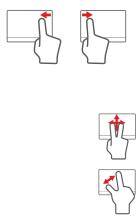
14 - Touchpad
This allows you to control applications with a few simple gestures, such as:
•Swipe in from edge: Access Windows tools by swiping into the center of the touchpad from the right or left edge.
•Swipe in from right: Toggle the charms.
•Swipe in from left: Switch to the previous app.
•Two-finger slide: Swiftly scroll through web pages, documents and playlists by placing two fingers on the touchpad and moving both in any direction.
•Two-finger pinch: Zoom in and out of photos, maps and documents with a simple finger-and-thumb gesture.
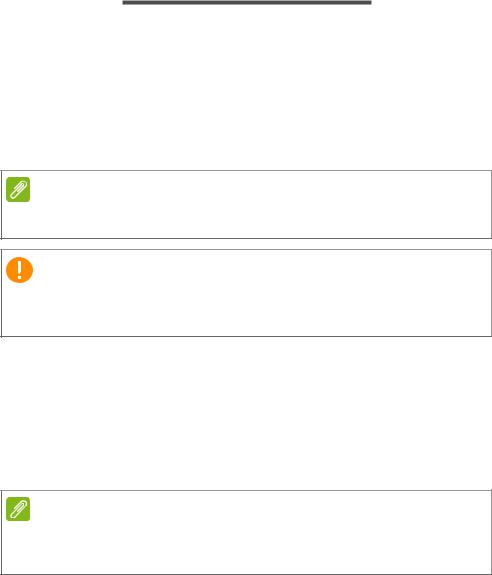
Recovery - 15
RECOVERY
If you are having trouble with your computer, and the frequently asked questions (see Frequently asked questions on page 68) do not help, you can 'recover' your computer - i.e. return it to an earlier state.
This section describes the recovery tools available on your computer. Acer provides Acer Recovery Management, which allows you to create a recovery backup, a drivers and applications backup, and to start recovery options, either using Windows tools, or the recovery backup.
Note
Acer Recovery Management is only available with a pre-installed Windows operating system.
Important
We recommend that you create a Recovery Backup and Drivers and Applications Backup and as soon as possible.
In certain situations a full recovery will require a USB recovery backup.
Creating a recovery backup
To reinstall from a USB storage drive, you must first create a recovery backup. The recovery backup includes the entire original contents of your computer’s hard drive, including Windows and all factory-loaded software and drivers. Using this backup will restore your computer to the same state as when you purchased it, while giving you an option to retain all settings and personal data.
Note
Since the recovery backup requires at least 16 GB of storage after formatting, it is recommended to use a USB drive with a capacity of 32 GB or larger.
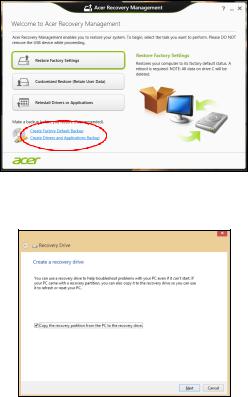
16 - Recovery
1.From Start, type 'Recovery' and then click Acer Recovery Management in the list of apps.
2.Click Create Factory Default Backup. The Recovery Drive window opens.
Make sure Copy contents from the recovery partition to the recovery drive is selected. This provides the most complete and safest recovery backup.
3. Plug in the USB drive then click Next.
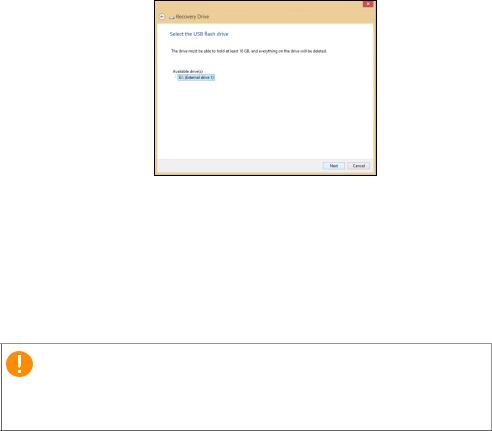
Recovery - 17
•Since the recovery backup requires at least 16 GB of storage after formatting, it is recommended to use a USB drive with a capacity of 32 GB or larger.
4.You will be shown the backup progress on the screen.
5.Follow the process until it completes.
6.After creating the recovery backup, you can choose to delete the recovery information on your computer. If you delete this information, you can only use the USB recovery backup to restore your computer, if you lose or erase the USB drive, you cannot restore your computer.
7.Unplug the USB drive and label it clearly.
Important
Write a unique, descriptive label on the backup, such as 'Windows Recovery Backup'. Make sure you keep the backup in a safe place that you will remember.
Creating a drivers and applications backup
To create a Drivers and Applications Backup, that contains the factory-loaded software and drivers needed by your computer, you
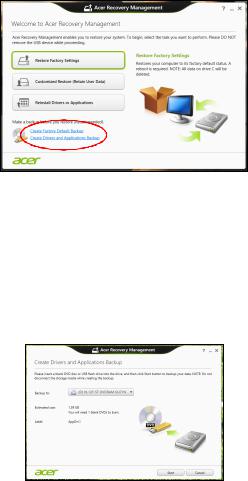
18 - Recovery
may use either a USB storage drive or, if your computer features a DVD recorder, one or more blank recordable DVDs.
1.From Start, type 'Recovery' and then click Acer Recovery Management in the list of apps.
2.Click Create Drivers and Applications Backup.
Plug in the USB drive or insert a blank DVD into the optical drive, then click Next.
•If you are using a USB drive, make sure your USB drive has enough capacity before continuing.
•If using DVDs, it will also show the number of blank, recordable discs you will need to complete the recovery discs. Make sure that you have the required number of identical, blank discs.
3.Click Start to copy files.You will be shown the backup progress on the screen.
4.Follow the process until it completes:
•If you are using optical discs, the drive ejects each disc as it completes burning it. Remove the disc from the drive and mark it

Recovery - 19
with a permanent marker.
If multiple discs are required, insert a new disc when prompted, then click OK. Continue until the process is complete.
• If you are using a USB drive, unplug the drive and label it clearly.
Important
Write a unique, descriptive label on each backup, such as 'Drivers and Applications Backup'. Make sure you keep the backup in a safe place that you will remember.
Recovering your system
To recover your system:
1.Perform minor fixes.
If only one or two items of software or hardware have stopped working correctly, the problem may be solved by reinstalling the software or the device drivers.
To reinstall software and drivers that were pre-installed at the factory, see Reinstalling drivers and applications on page 20. For instructions on reinstalling software and drivers that were not pre-installed, see that product’s documentation or support Web site.
2.Revert to a previous system condition.
If reinstalling software or drivers does not help, then the problem may be solved by returning your system to a previous state when everything was working correctly.
For instructions, see Returning to an earlier system snapshot on page 22.
3.Reset your operating system.
If nothing else has solved the problem and you want to reset your system, but keep your user information, see Returning your system to its factory condition on page 23.
4.Reset your system to its factory condition.
If nothing else has solved the problem and you want to reset your system to factory condition, see Returning your system to its factory condition on page 23.
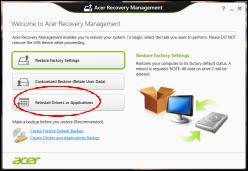
20 - Recovery
Reinstalling drivers and applications
As a troubleshooting step, you may need to reinstall the applications and device drivers that came pre-installed on your computer from the factory. You can reinstall using either your hard drive or the backup you have created.
•Other applications - If you need to reinstall software that did not come pre-installed on your computer, you need to follow that software’s installation instructions.
•New device drivers - If you need to reinstall device drivers that did not come pre-installed on your computer, follow the instructions provided with the device.
If you are reinstalling using Windows and the recovery information stored on your computer:
1.From Start, type 'Recovery' and then click Acer Recovery Management in the list of apps.
2. Click Reinstall Drivers or Applications.
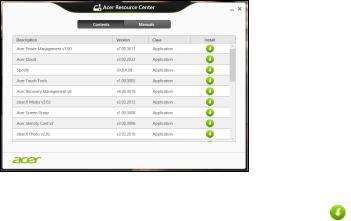
Recovery - 21
3.You should see the Contents section of the Acer Resource Center.
Images for reference only.
4.Click the install icon for the item you want to install, then follow the onscreen instructions to complete the installation. Repeat this step for each item you want to reinstall.
If you are reinstalling from a Drivers and Applications Backup on a DVD or USB drive:
1.Insert the Drivers and Applications Backup into the disc drive or connect it to a free USB port.
•If you inserted a DVD wait for Acer Resource Center to start.
•If Acer Resource Center does not start automatically, press the Windows key + <E>, then double-click on the optical drive icon.
•If you are using a USB drive, press the Windows key + <E>, then double-click on the drive that contains the backup. Double-click on ResourceCenter.
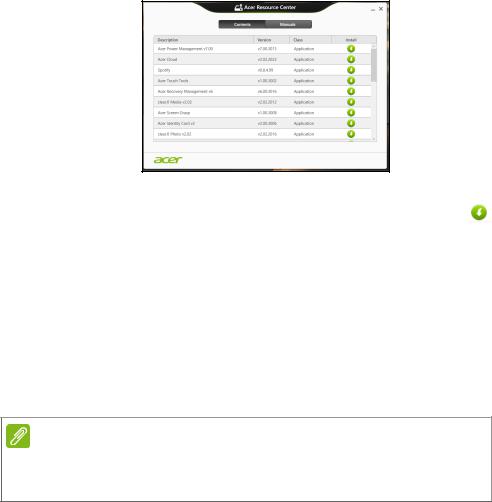
22 - Recovery
2.You should see the Contents section of the Acer Resource Center.
Images for reference only.
3.Click the install icon for the item you want to install, then follow the onscreen prompts to complete the installation. Repeat this step for each item you want to reinstall.
Returning to an earlier system snapshot
Microsoft System Restore periodically takes a 'snapshot' of your system settings and saves them as restore points. In most cases of hard-to-resolve software problems, you can return to one of these restore points to get your system running again.
Windows automatically creates an additional restore point each day, and also each time you install software or device drivers.
Note
For more information about using Microsoft System Restore, from Start, type ’Help’ and then click Help and Support in the list of apps. Type ’Windows system restore’ in the Search Help box, then press Enter.
Returning to a restore point
1.From Start, type ’Control Panel’ and then click Control Panel in the list of apps.
2.Click System and Security > Action Center, then click Recovery at the bottom of the window.
3.Click Open System Restore, then Next.

Recovery - 23
4.Click the latest restore point (at a time when your system worked correctly), click Next, then Finish.
5.A confirmation window appears; click Yes. Your system is restored using the restore point you specified. This process may take several minutes, and may restart your computer.
Returning your system to its factory condition
If your computer experiences problems that are not recoverable by other methods, you may need to reinstall everything to return your system to its factory condition. You can recover from either your hard drive or the recovery backup you have created.
•If you can still run Windows and have not deleted the recovery partition, see Recovering from Windows below.
•If you cannot run Windows, your original hard drive has been completely re-formatted or you have installed a replacement hard drive, see Recovering from a recovery backup on page 26.
Recovering from Windows
Start Acer Recovery Management:
•From Start, type ’Recovery’ and then click Acer Recovery Management in the list of apps.
Two options are available, Restore Factory Settings (Reset my PC) or Customized Restore (Refresh my PC).
Restore Factory Settings deletes everything on your hard drive, then reinstalls Windows and all software and drivers that were pre-installed on your system. If you can access important files on your hard drive, back them up now. See Restore Factory Settings with Acer Recovery Management on page 24.
Customized Restore will attempt to retain your files (user data) but will reinstall all software and drivers. Software installed since you purchased your PC will be removed (except software installed from
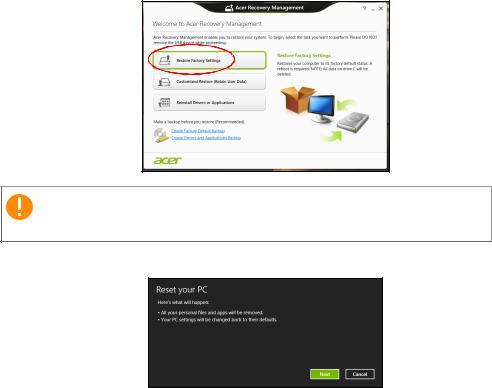
24 - Recovery
the Windows Store). See Customized Restore with Acer Recovery Management on page 25.
Restore Factory Settings with Acer Recovery Management
1. Click Restore Factory Settings.
Important
’Restore Factory Settings’ will erase all files on your hard drive.
2. The Reset your PC window opens.
Images for reference only.
3.Click Next, then choose how to erase your files:
a.Just remove my files quickly erases all files before restoring your computer and takes about 30 minutes.
b.Fully clean the drive completely cleans the drive after each file is erased, so no files can be viewed after the recovery. Cleaning the drive takes much longer, up to 5 hours, but is much more secure as old files are completely removed.
4.Click Reset.
